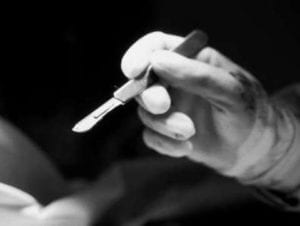Common dogma has it that no value can be placed on a human being. Our lives are priceless. So are our bodies.
If one location consistently and emphatically proves that dogma wrong, it is the hospital. If one hospital branch has the unmitigated ability to ruthlessly and immediately price every ounce of your flesh, bones, and blood, it is the ER.

On Halloween night, I decided to make a pumpkin pie. If you’re lazy, one of the main ingredients in this quasi-delicacy is canned pumpkin.
In the process of preparing the pie, I crossed what the triage nurse in the ER later wrote up on my records as an “evil can of pumpkin.” I opened the can. The lid sunk down, so I tried to push down on it with my hand. It remained stuck. I pushed harder.
Instead of yielding to the force of my hand, the lid propelled sideways with the deadly precision of an automated table saw. The result was a yawning, meaty canyon at the base of my index finger, a halved nerve, and a damaged tendon.
Ow.
I did not have health insurance when this happened.* The mindset associated with being uninsured goes something like this:
1) Injury occurs.
2) Decide whether you can fix it yourself. Can you duct tape, superglue, or sew it shut?
3) If you cannot fix it, do you have a friend who can?
4) Do you have enough time to drive or fly across the border to get it fixed?
5) Can the Internet help you fix it?
6) If you answer “no” to all of the above, go to the ER and incessantly ask them how much each procedure costs. (Since I don’t have an army of lawyers and accountants to negotiate my rates the way insurance companies do, I figured I’d try to get discounts right from the source.)
The people in the ER don’t know how much things cost. “Our priority is to get you fixed,” said the ER doctor, who sutured a pirate scar into the finger with the help of a tool he affectionately referred to as the “meatfinder.”
I imagine it’s better that way. But it would be nice to get an ER price menu for relatively minor emergencies like mine.
Two days later, a surgeon informed me that he would need to open up the finger again to repair the severed nerve and tendon. I read somewhere that doctors don’t treat uninsured patients as well as they do those with insurance, so I broached the discount topic with care.
“So, uh, do you have some billing people I can talk to?” I asked him.
“Why, don’t you have insurance?” He replied.
I shook my head. Luckily, this doctor acknowledges that the healthcare system is hard on people who aren’t insured or homeless, so he scheduled the surgery at a center with a cheaper rate than the community hospital.
“They only charge $57 a minute,” he assured me. If I bring several checks and pay everything upfront, I get a reasonable discount. This was within the realm of possibility, so I agreed.
I then visited my third bargaining destination, the ER’s billing office. They were the goldmine. I could get a 30% facilities discount on my visit there.
There is some wiggle room for uninsured people, after all–though not enough to justify not being insured, if you catch my drift.
After several phone calls, I have a fair estimate of what my finger repair is worth:
$595: ER facility fee with 30% discount
$350: ER doctor’s fee
$525: Surgery facility fee
$400: Anesthesiology fee
$1500: Plastic surgeon’s fee
TOTAL: $3,370
Note that the total is discounted in several ways. First, the surgery discount is contingent upon me paying for everything upfront–no credit cards. The plastic surgeon discounted his fee because he knows I’m self-insured (a fancy word for “lacking insurance”).
If I were on a payment plan, not only would I not get discounts, but I would be charged 18% interest on monthly payments. Ouch.
It’s fair to conclude that with opportunity costs (lost typing speed and slower mousing capabilities will be a big one after surgery), follow-up visits, cost of medication, cost of gas, etc., plus the potential costs associated with damaging any other area of the digit, my index finger is worth somewhere between $5,000 and $10,000.
I personally value it more highly than that, but I’m not going to ask the market to do the same.
Moral of the story: Insurance requires monthly payments. Freak accidents make these payments worth making.
*Colorado folk wisdom dictates that, if given a choice, you don’t need it until winter, when you are certain to bust a knee skiing. Colorado folk wisdom does not acknowledge the fact that common kitchen devices can become minstrels of death in the proper circumstances.

